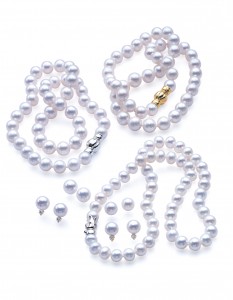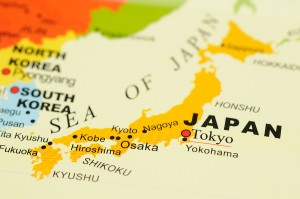SERIES 1: How to Shop for Pearls
Part 5 – Specifics for Picking Akoya Pearls
The next pearl we will look at is the Akoya or “saltwater” pearl. While Akoyas are sometimes referred to as “saltwater pearls,” this can be misleading as Tahitians and South Sea pearls can also be considered saltwater pearls; like Akoyas, they too are cultured in saltwater.
Akoya pearls are nucleated with a round bead (made from the shell of a mollusk), so the pearl is made up of layers of nacre over this bead. Because of this, Akoya pearls are generally very to perfectly round. So while grading doesn’t rely heavily on shape for Akoyas, there are some off-round and near-round Akoya pearls which are generally not desired. But Akoya pearls are also found in baroque shapes, which are favored by many individuals for their unique, tear-drop and pear shapes. Only 2-5 beads can be nucleated in each Akoya mollusk, and ultimately only 1, maybe 2 pearls are actually produced and able to be marketed. These numbers are drastically different than the number of Freshwater pearls that can be produced, making Akoya pearls much more rare and thus, more valuable.
The luster of Akoya pearls can be the sharpest of all the pearl types. Very high luster Akoyas will have such a sharp reflection that it is almost mirror-like. Though not exceptionally common, this kind of luster is highly sought after (and paid highly for!), especially in the larger the pearls. Because Akoya pearls only range in size from about 2mm-10mm, size weighs more heavily in the quality factors. Any Akoya pearls above 8mm tend to be on the rare side, with anything over 9mm being very rare.
Japan is essentially the only country producing Akoya pearls larger than 8mm, so quantity is low compared to many other pearl sizes and types available. And especially now, in the light of the recent earthquake/tsunami in Japan, this large-size Akoya industry is going to take a very big hit in the next 2-5 years with most of the future pearl harvests being affected. You might want to splurge on a larger size Akoya necklace now while there are still large strands to be found!
Akoya pearls on the market are generally found in 2 colors – white, which is naturally occurring, or black which is dyed. Akoyas may also be found in a natural blue color, which can range from gray/silver to icy, sky blue. Within the white Akoyas, these pearls have 3 major overtone colors that are found in subtle addition to the white color – silver, cream/ivory, and rose. Choosing between these different overtones relies entirely on the buyer and their personal preference. Depending on one’s skin tone, certain overtones will look better than others, so it’s important to try a variety on your own skin and compare how the pearls complement your skin. For example, I have very rosy undertones in my skin, and thus, pearls with a rose overtone look completely drab and blend in with my skin. Pearls with a cool, silver overtone, however, is a very striking complement to my skin’s rose undertones and make the pearls “pop” next to my skin. It’s quite amazing when you see in person how the difference in the overtones with your skin can affect the look of the pearls.
The vast majority of ALL Akoyas (and most Freshwaters too!) on the market have been bleached at some point to improve the whiteness and evenness of their color. Then, many Akoyas have been tinted with a process calling “pinking.” Pinking involves letting the pearls soak in a diluted red dye to give them a lovely, rosy pink overtone. Both bleaching and pinking are considered in the industry as a standard process of production, and not an actual “treatment.” Treatments are deemed to alter or enhance the pearl by outside means that increases the value or beauty of the pearl. Companies that sell pearls are only required to divulge to their customers any “treatments” that have been done on the pearls. Though the bleaching and pinking of pearls DOES actually enhance the beauty and raise the value of the pearls, the practice of bleaching and pinking has been going on for so many years (almost 100 for bleaching!) that they has become just standard industry practices and companies don’t mention their pearls are bleached or pinked. This is just information that is helpful to know about the average pearl. Since bleaching and pinking are so widespread and common in the industry, I don’t feel it is a factor that should concern one in making a pearl purchase.


